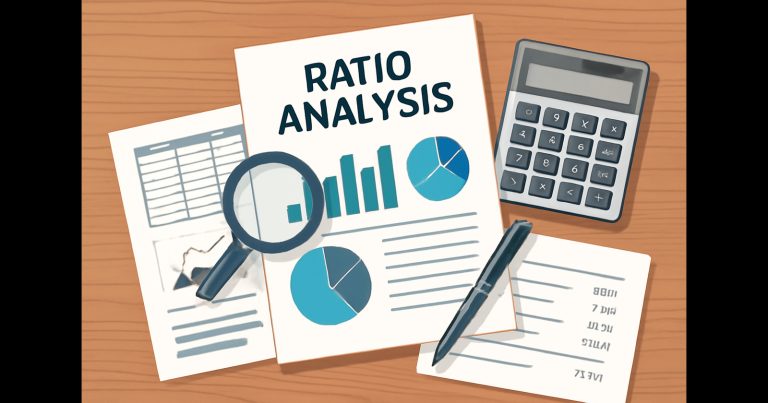The Advantages and Disadvantages of Ratio Analysis indicate the importance of ratio analysis and its limits. Ratio analysis is the power tool for the evaluation of financial statements, as it is a source of profitable analysis, liquidity, and operational efficiency. However, in spite of the richness in metrics, ratio analysis suffers from some limitations related to historical data dependence and absence of external economic contexts.
Meaning of Ratio Analysis
Ratio analysis is a quantitative tool used in the interpretation of financial statements through the computation of ratios from information acquired from balance sheets, income statements, and cash flow statements. It helps to generate comparisons on various figures in order to allow stakeholders to understand the health of company finances, its operating efficiency, as well as profitability; thus, it is highly used by all the stakeholders, management, investors, and creditors.
Basic tools in financial analysis, ratio analysis provides support with internal assessments as well as performing external comparisons for stakeholders.
What are the Types of Ratio Analysis?
Ratio analysis comprises several types of ratios, which are categorized into different aspect analysis across the performance of a firm. Various types help stakeholders get insight into profitability, efficiency, liquidity, and financial stability in providing a comprehensive financial picture of the company.
Liquidity Ratios:
– Measure a company’s ability to meet short-term obligations.
– Examples include Current Ratio and Quick Ratio.
Profitability Ratios:
– Evaluate a company’s ability to generate profits relative to sales, assets, or equity.
– Examples include Gross Profit Margin, Net Profit Margin, and Return on Equity (ROE).
Leverage Ratios:
– Assess the extent of a company’s debt relative to equity or assets, indicating financial stability and risk.
– Examples include Debt-to-Equity Ratio and Interest Coverage Ratio.
Efficiency Ratios:
– Analyze how effectively a company utilizes its assets and resources.
– Examples include Inventory Turnover Ratio and Asset Turnover Ratio.
Market Ratios:
– Focus on a company’s stock performance, providing insights for investors.
– Examples include Earnings Per Share (EPS) and Price-to-Earnings (P/E) Ratio.
Each type of ratio analysis plays a distinct role, allowing stakeholders to examine various facets of a company’s financial and operational performance.
What are Steps of Ratio Analysis?
Steps in ratio analysis include systematic procedures for working through calculations, interpretation, and usage of ratios to make financial decisions. These steps ensure accuracy and relevance in the assessment of financial performance.
- Collect Financial Data: Materials collected include financial statements: the balance sheet, income statement, and cash flow statement.
- Select Relevant Ratios: Choose ratios that meet the objectives of analysis: liquidity ratios for the cash flow evaluation or profitability ratios for performance analysis.
- Calculate Ratios: Use the formulas calculated above to calculate each ratio correctly, thereby avoiding misleading inferences.
- Interpret the Ratios: Analyze the calculated ratios to draw insights. Higher or lower values may indicate strengths or weaknesses depending on industry norms.
- Benchmark and Compare: Compare ratios with industry benchmarks, with historical performance, or against competitors to measure relative performance.
- Decision-Making: Using the interpretation, decisions on management, investment or lending can be made.
Following these steps helps ensure ratio analysis is accurate and effective for assessing and comparing financial performance.
What are the Advantages of Ratio Analysis?
The advantages of ratio analysis make it an essential tool for financial analysis, helping stakeholders assess a company’s financial position, operational efficiency, and long-term viability.
- Simplifies Financial Data Interpretation: Ratios condense complex financial information into understandable metrics, making it easier to assess financial health quickly.
- Enables Benchmarking: Ratio analysis allows for comparisons with industry standards, competitors, and historical data, helping identify areas where the company excels or underperforms.
- Supports Decision-Making: Management, investors, and creditors use ratio analysis to make informed decisions about investment, financing, and operational strategies.
- Highlights Financial Trends: Ratio analysis can reveal trends over time, such as improving or declining profitability, enabling proactive measures to address emerging issues.
- Measures Efficiency and Profitability: Ratios like Return on Assets (ROA) and Gross Profit Margin assess a company’s efficiency in using its resources and generating profits.
- Aids in Financial Planning: Ratio analysis supports planning and forecasting, helping organizations set realistic financial goals based on current performance.
Ratio analysis provides valuable insights, making it a powerful tool for stakeholders looking to understand and improve financial performance.
What are the Disadvantages of Ratio Analysis?
Despite these numerous benefits, there are several disadvantages of ratio analysis that limit its effectiveness. Knowledge of these limitations is important for effective use and avoidance of misinterpretations.
- Lack of Context: Ratios do not consider external factors like economic conditions, market changes, or industry-specific issues that impact financial performance.
- Historical Data Dependence: Ratio analysis relies on past financial data, which may not accurately reflect current or future performance, especially in rapidly changing industries.
- Inconsistent Accounting Practices: Different companies may use varying accounting methods, making it difficult to compare ratios across companies accurately.
- Limited Scope for Non-Financial Factors: Ratio analysis focuses on financial data and overlooks non-financial factors such as customer satisfaction, brand value, and employee productivity.
- Subject to Manipulation: Ratios can be manipulated by adjusting accounting policies or financial statements, potentially misleading stakeholders.
- Challenges in Setting Standards: Setting industry-wide benchmarks or standards for ratios can be challenging, as performance varies widely across sectors and company sizes.
The disadvantages of ratio analysis emphasize the need for a comprehensive approach, combining ratios with other tools and data to ensure accurate evaluations.
Conclusion
Advantages and Disadvantages of Ratio Analysis highlight that ratio analysis is actually a critical tool through which the company’s performance, liquidity, and profitability can be understood. Although ratio analysis reduces the complexity of financial data, helps decision-making, and enables the benchmarking of performances, it is, on the other hand, limited by issues such as historical dependency, lack of context, and the element of manipulation or falsification. Effective use of ratio analysis should therefore occur with other analytical methods and considerations of external factors. Understanding the benefits versus the limitations ensures a balanced approach toward financial evaluation, enabling stakeholders to make informed and accurate decisions.
Advantages and Disadvantages of Ratio Analysis FAQs
What is the primary purpose of ratio analysis?
Ratio analysis helps simplify and interpret financial data, making it easier to evaluate a company’s performance, efficiency, and financial stability.
How does ratio analysis benefit investors?
Investors use ratio analysis to compare companies, assess profitability, and make informed investment decisions based on financial health.
What are liquidity ratios?
Liquidity ratios measure a company’s ability to meet its short-term obligations, such as the current ratio and quick ratio.
Can ratio analysis be misleading?
Yes, limitations like historical data reliance, accounting inconsistencies, and potential manipulation can impact the accuracy of ratio analysis.
Why is trend analysis important in ratio analysis?
Trend analysis helps track financial performance over time, revealing patterns and trends that guide strategic decision-making.


